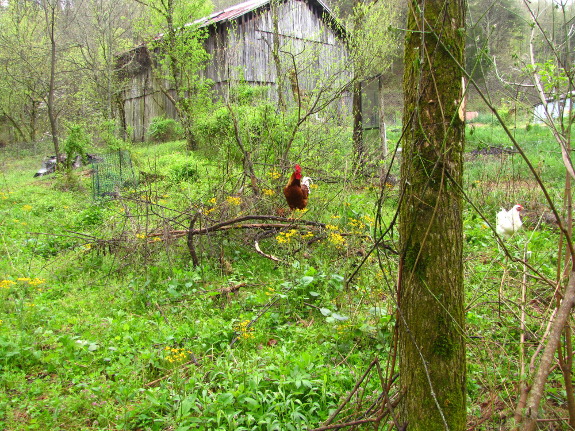
We moved the flock on to
their newest pasture on April 20. The first and second
pastures we fenced
in this year were on a grassy slope at the edge of the garden and were
pretty similar to what traditional pastured poultry farmers graze their
chickens on. But this third pasture is closer to what I’m aiming
for in the long run — a true forest pasture, with some scrubby
box-elders, a big black walnut, spicebushes, elderberries, and a new
Illinois everbearing mulberry (fenced off to protect its mulch from
chicken feet.)
When we cleared the
nearby garden patch five years ago, we threw the branches over the
fence and into what has become our newest chicken pasture. Our
rooster was thrilled to have a higher spot to stand guard while his
ladies went about their foraging and I think the whole flock will also
enjoy this spot’s shadiness — their previous pasture was already
starting to get a bit hot for comfort in the afternoons.
The groundcover in the new
pasture is so variable that I can’t even list all of the components —
a good sign since chickens like variety. Due to partial shade,
there are only a few patches of grass and most of the ground is instead
covered with chickweed, cleavers, violets, golden ragwort, lots of
Japanese honeysuckle (hopefully it won’t be a problem!), virgin’s
bower, crowfoot, and purple dead-nettle. Actually, there are
probably a lot of other types of plants present — those are just the
ones that jumped out at me as I watched the chickens forage on their
first, drizzly morning.
I expected the chickens to
demolish the chickweed that is copiously covering the ground, but the
plants are going to seed and must not be as tasty in this stage.
Instead, everybody went straight for the developing fruits atop the
small-flowered crowfoot (Ranunculus
abortivus), a
weedy relative of the buttercup. The other top choice was
scratching through fallen leaves in search of worms.
Although our chickens
are great foragers, we added in a few design features to tempt them to
spend even more time in the pasture. I feed the flock just inside
a door halfway down the length of the pasture, and the chicken waterer is screwed onto a tree a
good distance away. Since chickens tend to hang out near the food
and water, I figure this will help spread their impact around a bit
better.
